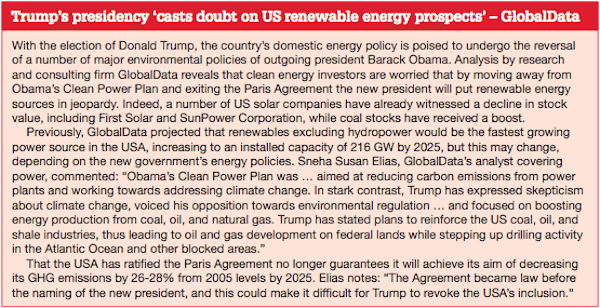Will a Trump administration in control of Congress put the USA’s climate policies into reverse?

Donald Trump’s surprise election victory has sparked a huge round of speculation about what his various promises and threats might mean for environmental legislation in the USA and the energy industry generally. Some of the speculation is too slanted to be taken seriously but a ‘can and can’t do’ assessment by Van Ness Feldman, of which the following is a digest, provides a more fact-based view.
Paris agreement
During his campaign, Donald Trump promised to withdraw the United States from the Paris Climate Agreement and vowed to eliminate greenhouse gas (GHG) emission regulations. Assuming that Trump seeks to fulfill these pledges, what steps will his administration take starting in January? There is great uncertainty about that, but it is possible to identify a set of pathways that his administration is likely to consider.
The USA joined the Paris Agreement by means of an executive action, so it is possible that another executive action would be enough for withdrawal. Alternatively, the Trump administration could follow the Agreement’s formal withdrawal process by providing written notice any time after three years from the date (November 4, 2016) that the agreement entered into force. If the new administration opted to honour the Agreement, it might issue a revised Nationally Determined Commitment for the United States, one reflecting a more modest set of GHG reduction measures than those submitted under Obama.
Carbon dioxide regulation
The Trump administration will have great difficulty in cancelling out GHG regulation altogether. Given the Supreme Court’s decision in Massachusetts v. EPA (a 2005 Appeal Court case from which, eventually, it was determined that the EPA should regulate six GHGs, including CO2, as harmful pollutants) the Trump administration could avoid Clean Air Act regulation of GHGs for power plants or other sources only if the EPA made a new scientific determination that GHGs do not endanger public health or welfare – and only if the agency could defend that determination in the courts.
If reversing the EPA’s findings proves too difficult, Trump’s administration could explore ways of unwinding or scaling back Obama’s policies. It could revisit GHG regulations such as those affecting the power, transport, and oil and gas sectors.
Two major power sector rules – the Carbon
Pollution Standards for new power plants and the Clean Power Plan Rule for existing power plants – are currently the subject of litigation. Trump could take legal steps to revise or even repeal the rules. However, the effectiveness of such actions is unclear, given that there are parties with a strong interest in defending the rules in court.
If the courts uphold the rules before they are revoked, Trump may want to modify them. For the Carbon Pollution Standards rule, a Trump EPA might rewrite the emission standard for new coal-fired power plants so that the standard is no longer set at a stringent CO2 emission performance level based on the use of carbon capture and sequestration (CCS), but instead on the use of advanced, highly efficient coal generation technology. Similarly, a Trump EPA might take a number of approaches in revisiting the Clean Power Plan rule. For example, it could reverse the agency’s current statutory interpretation of its authority under Section 111(d) and conclude that it bars the EPA from promulgating an emission guideline for a source category already subject to regulation for its air toxic emissions under Section 112 of the Clean Air Act. This interpretation could effectively prevent the use of Section 111(d) to set GHG standards for any of the industrial source categories already subject to toxic emission standards.
Alternatively, the EPA could revisit the ‘Best System of Emission Reduction’ methodology it used to establish emission guidelines under the Clean Power Plan Rule. Performance standards would be set at a level that assumes only those reductions achievable through measures that can be implemented at a plant. At the same time, the agency could continue to recognise the discretion of states to authorise compliance through flexible means such as emissions trading, resulting in less stringent obligations and lower cost of compliance.
Oil and gas
In the oil and gas sector, a Trump EPA might revisit (through a rulemaking) the methane standards set by the Obama administration for new and modified facilities under section 111(b) of the CAA – possibly by determining that the quantity of methane emissions from the sector are not substantial enough to endanger public health. By revoking the 111(b) rule, the Trump administration could avoid an obligation to follow through with regulation of methane emissions from existing facilities under CAA 111(d).
Implementing these revisions would require EPA to undertake new notice- and-comment rulemakings, as part of which it would have to supply a ‘reasoned explanation’ to support its change of course.
Budgetary control
Given Republican control of both the Senate and the House of Representatives, Trump might also have the power to block or shape the implementation of climate change policies developed by the previous administration. The president’s allies could include riders in the budget that would prevent the Executive from spending money on climate change policies or that would repeal or reform those policies. To expedite congressional action, Congress could pass the budget through the ‘reconciliation’ process, which would eliminate the possibility of a Senate filibuster.
A Republican Senate could do away with or limit the filibuster rule for legislation, which would pave the way to more sweeping changes, including amending the Clean Air Act by removing or curtailing its authority to regulate pollutants such as GHGs.
